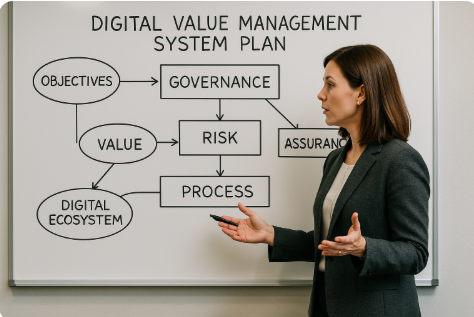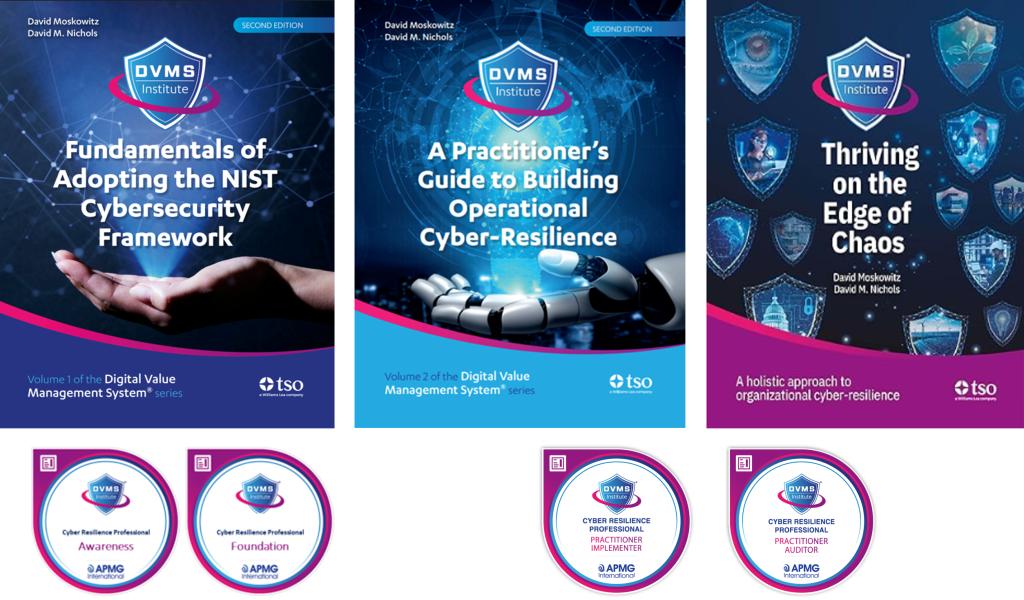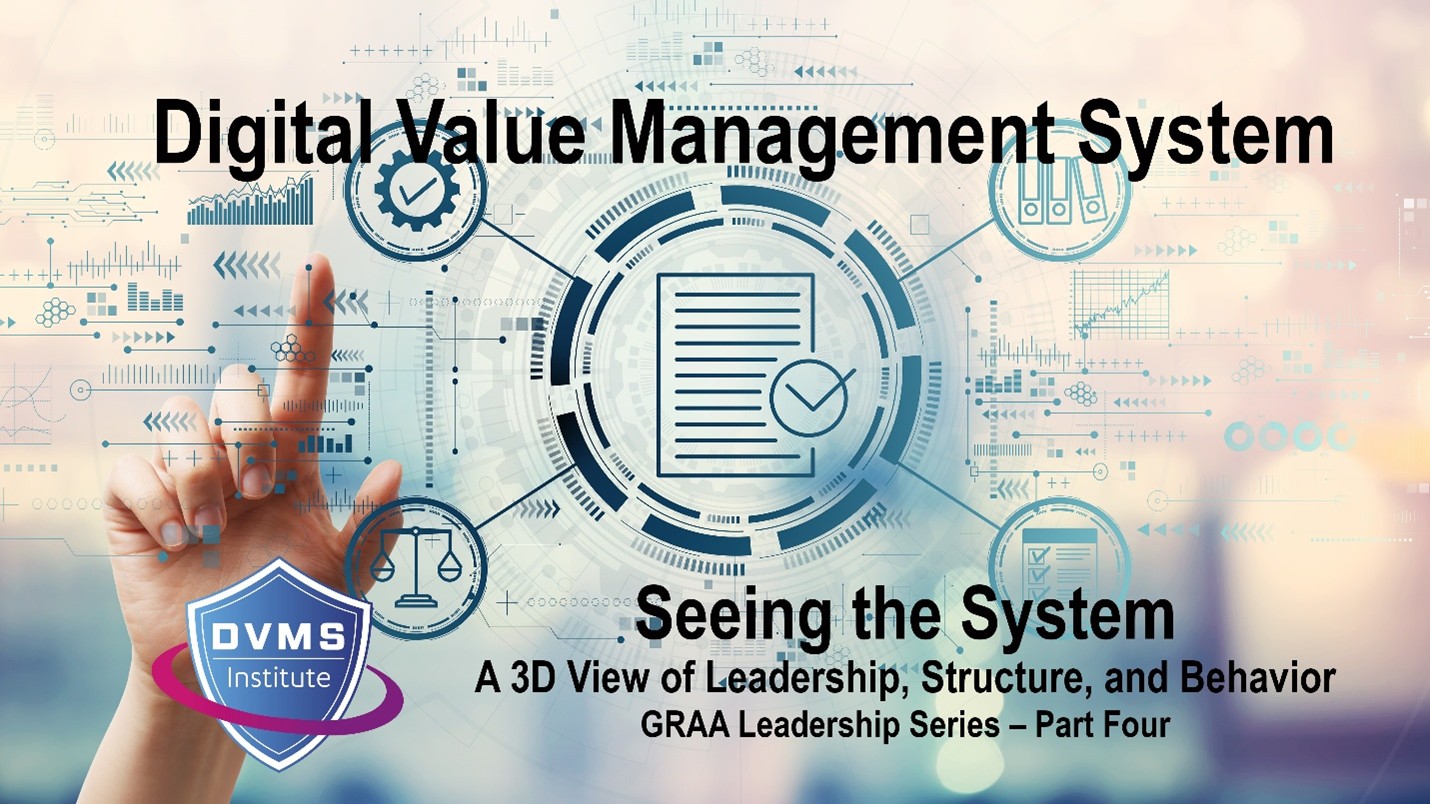Ten Reasons Why Organizations Must Define Their Digital Value Management Strategy (DVMS) Before Buying A GRC Platform
Rick Lemieux – Co-Founder and Chief Product Officer of the DVMS Institute
Reason #1 – Because Technology Can’t Fix What Governance Hasn’t Defined
Most organizations rush to buy technology before they’ve defined the governance system that the technology is supposed to support. This is a classic mistake in digital risk management. A GRC or resilience platform can automate workflows, track controls, and generate dashboards—but it cannot define accountability, purpose, or assurance.
The DVMS Institute’s DVMS defines how your organization is governed, managed, and assured in a digital ecosystem. It provides the rules of engagement between people, process, and technology. Without understanding this system, the platform you choose—no matter how advanced—will simply automate confusion.
Educating your organization on the DVMS ensures you first design the system of governance, so that when you do buy technology, it fits into a coherent framework rather than trying to create one.
GRC tools manage data; DVMS manages decisions. Without the latter, the former has no direction.
Reason #2 – Because DVMS Defines the “Why” Behind Digital Governance
Before choosing a tool, every stakeholder—executives, compliance officers, risk analysts, IT leaders—needs to agree on a single, unified answer to:
“Why do we manage digital risk?”
The DVMS answers this question by connecting digital risk management to value creation and assurance. It treats cybersecurity, resilience, and compliance not as overhead functions, but as contributors to business performance.
Educating the organization in DVMS helps everyone see that:
- Governance defines intent (why we do what we do).
- Risk management manages uncertainty (what might prevent us from doing it).
- Assurance provides confidence (evidence that we’re doing it effectively).
Once the DVMS helps everyone see the relationship between Governance, Risk, and Assurance, technology selection becomes a strategic, rather than a reactive, process. You buy platforms to support your value system, not just to meet a compliance deadline.
Reason #3 – Because Platforms Don’t Build Resilience — People and Systems Do
The DVMS overlay system emphasizes that resilience is a capability, not a software feature.
GRC platforms can help you manage risk data, but they can’t teach people how to interpret it, act on it, or learn from it. They can’t instill accountability or a culture of assurance.
Educating your teams on DVMS before procurement:
- Creates organizational literacy around risk, governance, and assurance.
- Helps executives, managers, and engineers speak the same “resilience language.”
- Builds a shared mental model of how digital business risk translates into operational performance.
With that shared understanding in place, your eventual platform becomes an enabler of human capability, not a substitute for it.
Without DVMS education, technology manages information. With DVMS education, people manage outcomes.
Reason #4 – Because DVMS Aligns Governance, Risk, and Assurance Before You Automate
Automation without alignment is chaos. A platform can make processes faster—but if those processes aren’t aligned to your governance objectives, all you’ve done is accelerate misalignment.
DVMS provides the alignment blueprint between:
- Governance – Who decides and directs?
- Risk Management – What uncertainties threaten performance?
- Assurance – How do we prove that we’re effective?
Educating the organization in DVMS ensures these three disciplines are integrated before you digitize or automate them. That way, when you eventually select a platform, it fits into a structure where data, accountability, and performance are already connected.
The DVMS prevents what many organizations experience after implementing GRC tools: “tool drift”—where the technology becomes the focus rather than the system it’s meant to support.
Reason #5 – Because It Ensures You’re Solving the Right Problem
Most organizations approach cyber risk as a technology problem. It isn’t—it’s a management system problem. Buying a platform without understanding the DVMS is like buying accounting software without understanding basic finance.
Educating your organization on DVMS helps you identify:
- Whether your current problem is a governance issue, a process issue, or a data issue.
- What information do you need from a GRC or resilience platform to make decisions?
- How your technology investments should align with your value governance objectives.
The DVMS prevents the all-too-common scenario where organizations spend millions on software only to discover they lack the internal maturity to use it effectively.
Reason #6 – Because DVMS Embeds Continuous Learning and Improvement
DVMS is built on the 3D Knowledge Model: Discover, Define, and Demonstrate.
This model transforms digital governance into a continuous cycle of learning and assurance:
- Discover: Identify risks, uncertainties, and performance gaps.
- Define: Establish governance, policies, and processes to manage them.
- Demonstrate: Operate, measure, and improve to assure outcomes.
When an organization is educated on DVMS, it understands that governance is not a one-time project—it’s a learning system.
Technology becomes a participant in that system, not its foundation. Your GRC or resilience platform can then be configured to collect and report on evidence that supports “Demonstrate” activities, providing insights that feed back into “Discover” and “Define.”
Without DVMS literacy, organizations typically use platforms as static control trackers, not as engines of continuous improvement.
Reason #7 – Because It Prevents You from Automating Ineffective Processes
One of the most significant risks in digital transformation is automating what’s broken.
If your governance, risk, and assurance processes are unclear or misaligned, a GRC platform will merely exacerbate the dysfunction.
DVMS education equips your teams with the tools to map, measure, and enhance your current processes before implementing automation. It helps you:
- Identify decision bottlenecks and gaps in accountability.
- Eliminate redundant or conflicting controls.
- Standardize how assurance is gathered and reported.
By teaching teams to think systemically, you ensure that when automation happens, it’s built on stable, verified foundations.
The DVMS ensures you digitize clarity, not confusion.
Reason #8 – Because It Builds Executive and Board-Level Confidence
Boards and executive teams increasingly demand assurance that cyber investments translate into measurable resilience. The DVMS provides a language of assurance—one that connects risk, governance, and value directly to performance outcomes.
Educating leadership on the DVMS ensures they understand:
- How to interpret GRC or risk metrics within the context of governance objectives.
- What “assurance” really means beyond compliance checklists.
- How to use DVMS evidence to demonstrate resilience to regulators, partners, and customers.
The DVMS not only informs smarter purchasing decisions but also strengthens organizational credibility and trust.
Reason #9 – Because DVMS Turns Platform Procurement into Strategic Enablement
Once your teams understand DVMS principles, your platform selection process changes entirely. Instead of asking vendors, “What features do you have?”, you start asking:
- “How does your platform support governance and assurance loops?”
- “Can you show how your tool enables continuous improvement across Discover–Define–Demonstrate?”
- “Can your system measure digital value performance, not just compliance?”
DVMS principles transform procurement from a technical evaluation into a strategic enablement exercise, aligning every technology investment with measurable business outcomes.
Reason #10 – Because Education Is Cheaper Than Misalignment
Finally, there’s a financial argument. A DVMS education program—training executives, managers, and practitioners on how digital governance systems work—is a fraction of the cost of an enterprise GRC implementation.
Yet it dramatically reduces risk by ensuring that:
- You purchase the right platform for your maturity level.
- You configure it for the right purposes.
- You realize value from it faster.
Educating your organization in DVMS first is not a delay—it’s an acceleration. It ensures every dollar spent on technology produces measurable improvements in resilience and performance.
Conclusion: Systems First, Software Second
A platform can automate governance, but it can’t create it. It can measure controls, but not confidence. It can centralize data, but not leadership.
That’s why the first investment any organization should make is not in a tool, but in understanding the system that makes the tool effective.
A Digital Value Management Strategy provides organizations with a way to connect digital governance, risk management, and assurance into a single, learning-driven model.
Once your people understand the DVMS, any platform you choose becomes an amplifier of resilience—not just a repository of compliance.
Educate first, automate second. That’s how you build a system that turns digital risk into digital value, enabling operational resilience and trust with your stakeholders.
About the Author

Rick Lemieux
Co-Founder and Chief Product Officer of the DVMS Institute
Rick has 40+ years of passion and experience creating solutions to give organizations a competitive edge in their service markets. In 2015, Rick was identified as one of the top five IT Entrepreneurs in the State of Rhode Island by the TECH 10 awards for developing innovative training and mentoring solutions for boards, senior executives, and operational stakeholders.
Digital Value Management System® (DVMS)
The DVMS is an adaptive, culture-enabled overlay system designed to help organizations of any size transition from static, paper-based governance systems to a living, evidence-based system of Governance, Resilience, Assurance, and Accountability (GRAA).
At its core, the DVMS is a simple but powerful integration of:
-
Governance Intent – shared expectations and accountabilities.
-
Operational Capability – how the business actually performs
-
Assurance Evidence – proof that intended outcomes are being achieved
Rather than adding more complexity, a DVMS integrates Fragmented Governance Frameworks and Practices such as NIST CSF, GRC, ITSM, DevOps, and AI into a unified overlay system that enables leaders and regulators to see, in real time, whether the digital business is working as intended—and whether the risks that matter most are being managed proactively.

Through its MVC, CPD, 3D Knowledge, and FastTrack Models, a DVMS turns this integration into three distinctive capabilities:
A Governance Overlay that replaces fragmentation with unity. The DVMS provides organizations with a structured way to connect strategy with day-to-day execution. Leaders gain a consistent mechanism to direct, measure, and validate performance—across every system responsible for digital value.
A Behavioral Engine that drives high-trust, high-velocity decision-making. The DVMS embeds decision models and behavioral patterns that help teams think clearly and act confidently, even in uncertain situations. It is engineered to reduce friction, prevent blame-based cultures, and strengthen organizational reliability.
A Learning System that makes culture measurable, adaptable, and scalable. Culture becomes a managed asset—not an abstract concept. The DVMS provides a repeatable way to observe behavior, collect evidence, learn from outcomes, and evolve faster than threats, disruptions, or market shifts.
DVMS Organizational Benefits
Instead of replacing existing operational frameworks, the DVMS elevates them—connecting and contextualizing their data into actionable intelligence that validates performance and exposes the reasons behind unmet outcomes.
By adopting a DVMS, organizations are positioned to:
- Maintain Operational Stability Amidst Constant Digital Disruption
- Deliver Digital Value and Trust Across A Digital Ecosystem
- Satisfy Critical Regulatory and Certification Requirements
- Leverage Cyber Resilience as a Competitive Advantage
DVMS Leadership Benefits
The Digital Value Management System (DVMS) provides leaders with a unified, evidence-based approach to governing and enhancing their digital enterprise, aligning with regulatory requirements and stakeholder expectations.
For the CEO, the DVMS provides a clear line of sight between digital operations, business performance, and strategic outcomes—turning governance and resilience into enablers of growth and innovation rather than cost centers.
For the Board of Directors, the DVMS provides ongoing assurance that the organization’s digital assets, operations, and ecosystem are governed, protected, and resilient—supported by evidence-based reporting that directly links operational integrity to enterprise value and stakeholder trust.
For the CIO, CRO, CISO, and Auditors: an integrated, adaptive, and culture-driven governance and assurance management system that enhances digital business performance, resilience, trust, and accountability
DVMS White Papers
The three whitepapers below present a coherent progression that shifts organizations from compliance-driven thinking to a modern system of Governance, Resilience, Assurance, and Accountability (GRAA). Collectively, the three papers define a comprehensive system for building and governing resilient digital enterprises, grounded in evidence rather than assumptions.
The Assurance Mandate Paper sets the stage by showing why traditional GRC artifacts provide only reassurance—not evidence—and calls boards to demand forward-looking proof that their organizations can continue to create, protect, and deliver value under stress.
The Assurance in Action Paper elevates the conversation from leadership intent to managerial execution, demonstrating how the DVMS operationalizes resilience by translating outcomes into Minimum Viable Capabilities, connecting frameworks through the Create–Protect–Deliver model, and generating measurable assurance evidence that managers can use to demonstrate real performance rather than activity.
The Governing by Assurance Paper elevates the approach to the policy and regulatory level, showing how DVMS functions as a learning overlay system that links governance intent, operational capability, and verifiable evidence into a continuous loop—enabling regulators, agencies, and enterprises to govern by outcomes rather than checklists and to prove capability with measurable, auditable performance data.
DVMS Cyber Resilience Certified Training Programs
DVMS Cyber Resilience Awareness Training
The DVMS Cyber Resilience Awareness course and its accompanying body of knowledge publication educate all employees on the fundamentals of digital business, its associated risks, the NIST Cybersecurity Framework, and their role within a shared model of governance, resilience, assurance, and accountability for creating, protecting, and delivering digital value.
This investment fosters a culture that is prepared to operate within a system capable of transforming systemic cyber risks into operational resilience.
DVMS NISTCSF Foundation Certification Training
The DVMS NISTCSF Foundation certification training course and its accompanying body of knowledge publications provide ITSM, GRC, Cybersecurity, and Business professionals with a detailed understanding of the NIST Cybersecurity Framework and its role in a shared model of governance, resilience, assurance, and accountability for creating, protecting, and delivering digital value.
This investment fosters IT, GRC, Cybersecurity, and Business professionals with the skills to operate within a system capable of transforming systemic cyber risks into operational resilience.
DVMS Cyber Resilience Practitioner Certification Training
The DVMS Practitioner certification training course and its accompanying body of knowledge publications teach ITSM, GRC, Cybersecurity, and Business practitioners how to elevate investments in ITSM, GRC, Cybersecurity, and AI business systems by integrating them into a unified governance, resilience, assurance, and accountability system designed to proactively identify and mitigate the cyber risks that could disrupt operations, erode resilience, or diminish client trust.
This investment fosters IT, GRC, Cybersecurity, and Business practitioners with the skills to assess, design, implement, operationalize, and continually innovate a Digital Value Management System® program that operationalizes a shared model of governance, resilience, assurance, and accountability for creating, protecting, and delivering digital value.
Company Brochures and Presentation
Explainer Videos
- DVMS Architecture Video: David Moskowitz explains the DVMS System
- DVMS Case Study Video: Dr. Joseph Baugh Shares His DVMS Story.
- DVMS Overlay Model – What is an Overlay Model
- DVMS MVC ZX Model – Powers the CPD
- DVMS CPD Model – Powers DVMS Operations
- DVMS 3D Knowledge Model – Powers the DVMS Culture
- DVMS FastTrack Model – Enables A Phased DVMS Adoption
Digital Value Management System® is a registered trademark of the DVMS Institute LLC.
® DVMS Institute 2025 All Rights Reserved




